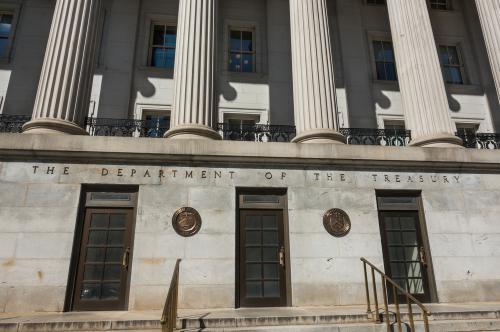In a discussion with Eugene Steuerle of the Urban Institute, Henry Aaron examines the fiscal problems facing America, and suggests tax and budget reform options to address these issues. Below is an excerpt from Aaron’s initial statement. The full discussion (which includes this essay, Steuerle’s statement, Aaron’s response, and Steuerle’s subsequent response) was first published in the Journal of Policy Analysis and Management.
“The long-term budget prospects of the United States are grim. Projected spending greatly exceeds projected revenue over the next few decades. Projected growth of health care spending accounts for more than all of the anticipated gap.
“Without action to narrow the gap, accumulating deficits will drive
up the ratio of debt to GDP. Interest payments will rise correspondingly.
At some point, domestic and foreign holders U.S. debt will
come to doubt the capacity of the government to service this debt.
At that point, they will demand sharply higher interest rates.
“The combination of increasing debt and rising interest rates will
cause debt service costs to explode. What follows would be some
combination of collapsing investment, declining production, debt
default, and inflation—in brief, a calamitous mess. That such a
mess will occur is certain if budget deficits as large as those
currently anticipated are realized. Precisely when is impossible to
forecast accurately.”
The Standard Scenario
The three preceding paragraphs
comprise a budget narrative, now
virtually standard among budget
analysts. It is reflected in long-term
budget projections that the Congressional
Budget Office (CBO) has been
publishing since 1997.2 It is the basis
for the work of at least two currently
active national commissions and
various reports.
Table 1, which reproduces
projections of the Congressional
Budget Office, support this narrative.
It shows a large and growing revenueexpenditure
gap. Over the next four
decades, growth of health care spending
accounts for more than all of the
gap. The debt/GDP ratio grows geometrically.
Table 1 is based on the
assumption that real interest rates are
unaffected by the debt/GDP ratio.
Thus, it omits any increase in borrowing
costs resulting from such a loss of
investor confidence in the capacity of
the government to meet debt service
obligations. Whenever any such loss
of confidence might occur, the immediate
result would be draconian policy
changes— default if the country
reneges on payment, hyperinflation if
it simply prints money to cover debt
service. Beyond some point, therefor
e, the interest rates implicit in table 1
are too low. And for that reason, table
1 is an unduly ‘optimistic’ projection
of the consequences of doing nothing
to close projected budget shortfalls.
These projections do not indicate
when, if policy is unchanged, the crash
will come. Nor do they show what
would need to be done, or how soon
it would need to be done, to prevent a
collapse of confidence.
To be sure, forecasts are
notoriously inaccurate. Projections,
which are just mindless extrapolations
of assumptions CBO analysts regard
as reasonable, are not meant to be even
as accurate as forecasts. Actual gaps
will almost certainly differ from those
shown in table 1, as exemplified by
shifts in estimates for 2020 between
June 2009 and March 2010 indicate.
Even allowing for massive uncertainty,
however, it is hard to imagine events,
other than explicit and large policy
changes, that would close the longterm
fiscal gap.
Table 1 also reveals another
key point—hyperventilated crisis
rhetoric about the anticipated growth
of Social Security receives no support
from these projections. Growth of
Social Security as a share of GDP is
small—just 1.2 percent of GDP by
2030, followed by actual decline, with
a total increase between 2010 and
2050 of just 0.9 percent of GDP.
Growth of Social Security spending is
a negligible part of the long-term fiscal
challenge.3 So, too, are entitlements
other than the ‘big three.’ The Office
of Management and Budget estimates
that spending on entitlements other
than Medicare, Social Security, and
Medicaid, will amount to $739 billion
or 5 percent of GDP in fiscal year
2010—slightly more than Social
Security.4 This massive, but often
neglected group of outlays, is projected
to grow with population and inflation
and, hence, to gradually shrink as a
share of GDP.
Actually, the long-term projections
in table 1 understate the size of
the budget challenge. It is based on
projections prepared before the full
effects of the current and on-going
economic slowdown made themselves
felt. Although most of the budgetary
damage done by the recession and
efforts to counter its effects are transitory,
their effects will linger in the form
of increased debt and interest outlays.
Furthermore, although the Congressional
Budget Office anticipates that the
economy will return to the same longterm
growth path foreseen before the
recession, some forecasters believe that
the rebound will be incomplete. If the
recession permanently lowered the
trajectory of full-employment GDP, it
also lowered full-employment revenues,
with no obvious impact on
government spending (other than a
small reduction in Social Security
spending), thereby widening the longterm
fiscal gap.
The Brookings Institution is committed to quality, independence, and impact.
We are supported by a diverse array of funders. In line with our values and policies, each Brookings publication represents the sole views of its author(s).



